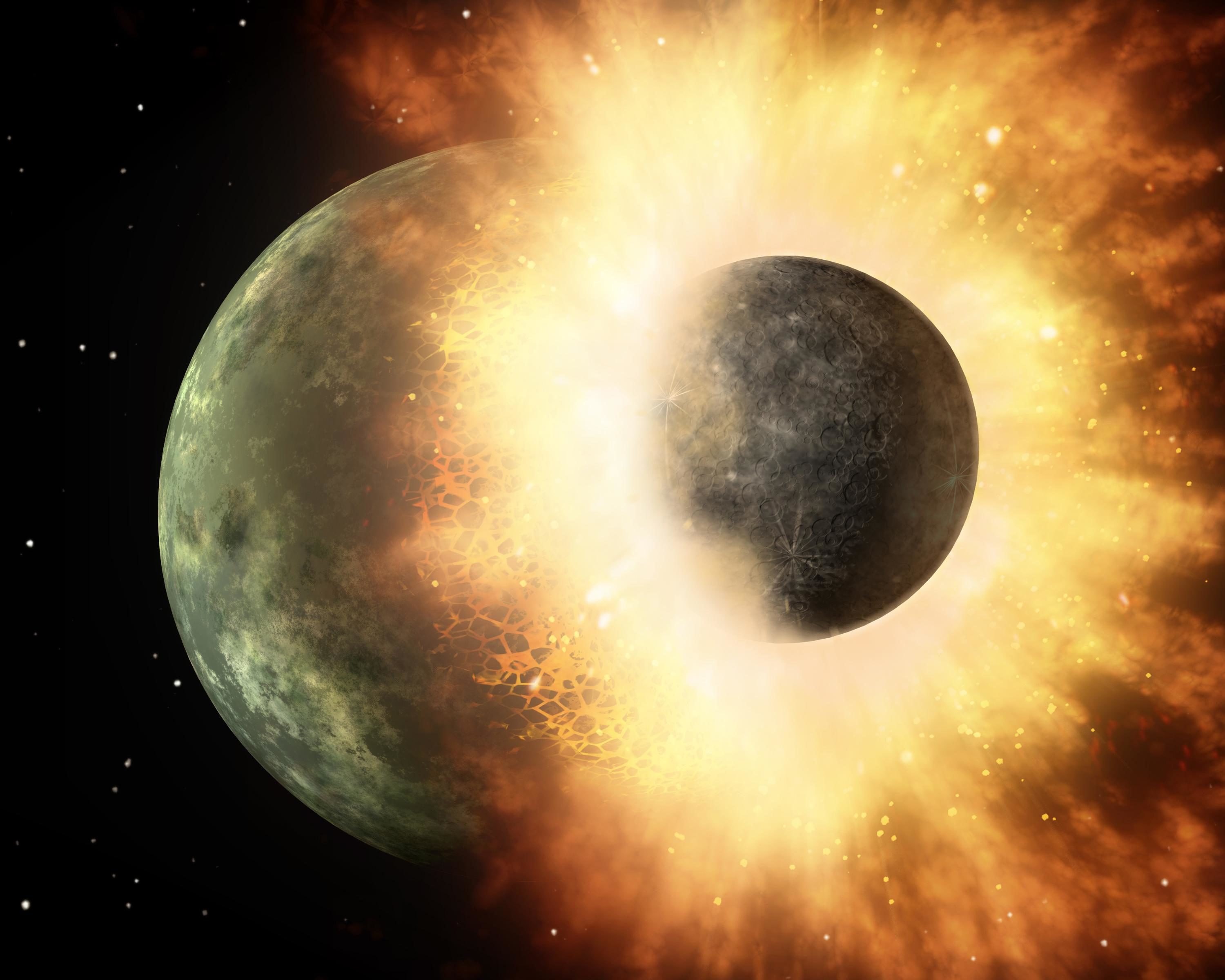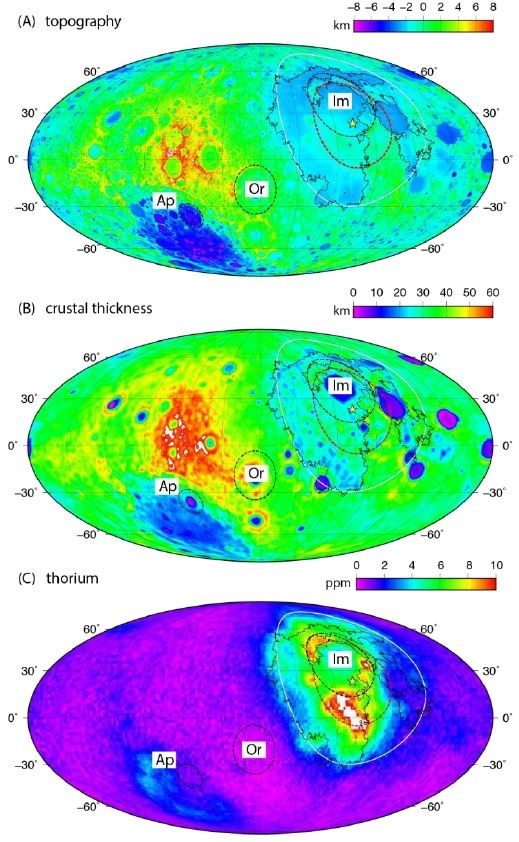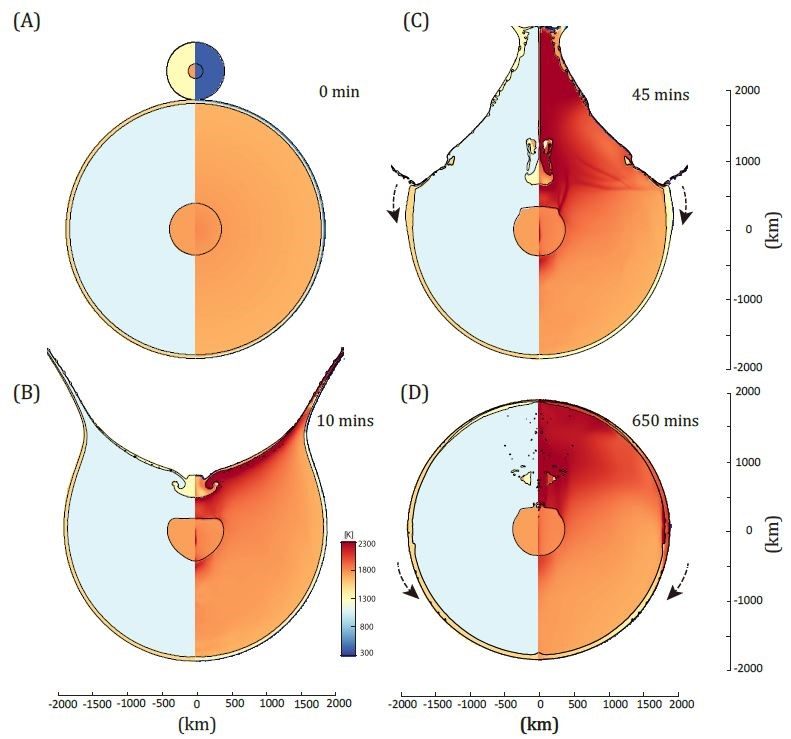
Now, new evidence about the Moon's crust suggests the differences were caused by a wayward dwarf planet colliding with the Moon in the early history of the solar system. A report on the new research has been published in AGU's Journal of Geophysical Research: Planets.
The mystery of the Moon's two faces began in the Apollo era when the first views of its farside revealed the surprising differences. Measurements made by the Gravity Recovery and Interior Laboratory (GRAIL) mission in 2012 filled in more details about the structure of the Moon - including how its crust is thicker and includes an extra layer of material on its farside.
There are a number of ideas that have been used to try and explain the Moon's asymmetry. One is that there were once two moons orbiting Earth and they merged in the very early days of the Moon's formation. Another idea is that a large body, perhaps a young dwarf planet, found itself in an orbit around the Sun that put it on a collision course with the Moon. This latter giant impact idea would have happened somewhat later than a merging-moons scenario and after the Moon had formed a solid crust, said Meng Hua Zhu of the Space Science Institute at Macau University of Science and Technology and lead author of the new study. Signs of such an impact should be visible in the structure of the lunar crust today.
"The detailed gravity data obtained by GRAIL has given new insight into the structure of the lunar crust underneath the surface," Zhu said.

They found the best fit for today's asymmetrical Moon is a large body, about 480 miles (780 kilometers) in diameter, smacking into the nearside of the Moon at 14,000 miles per hour (22,500 kilometers per hour). That would be the equivalent of an object a bit smaller than the dwarf planet Ceres moving at a speed about one-quarter as fast as the meteor pebbles and sand grains that burn up as "shooting stars" in Earth's atmosphere. Another good fit for the impact combinations the team modeled is a slightly smaller, 450-mile (720-kilometer) diameter, object hitting at a mildly faster 15,000 miles per hour (24,500 kilometers per hour).
Under both these scenarios, the model shows the impact would have thrown up vast amounts of material that would fall back on the Moon's surface, burying the primordial crust on the farside in 3 to 6 miles (5 to 10 kilometers) of debris. That is the added layer of crust detected on the farside by GRAIL, according to Zhu.
The new study suggests the impactor was not likely an early second moon of Earth's. Whatever the impactor was - an asteroid or a dwarf planet - it was probably on its own orbit around the Sun when it encountered the Moon, said Zhu.

"Our model can thus explain this isotope anomaly in the context of the giant impact scenario of the Moon's origin." the researchers write.
The new study not only suggests an answer to ongoing questions about the Moon, but may also provide insight into the structure of other asymmetrical worlds in our solar system like Mars wrote the researchers.
"This is a paper that will be very provocative," said Steve Hauck, a professor of planetary geodynamics at Case Western Reserve University and Editor-in-Chief of the JGR: Planets. "Understanding the origin of the differences between the nearside and the farside of the Moon is a fundamental issue in lunar science. Indeed, several planets have hemispherical dichotomies, yet for the Moon we have a lot of data to be able to test models and hypotheses with, so the implications of the work could likely be broader than just the Moon."



Reader Comments
Gregory Sitchin has theories based on his translation of Sumerian tablets but he suggested the Earth itself was were the asteroid belt is and the moon, which either suffered damage in the commotion or was the recipient of a large amount of debris, was "stolen" from the rogue planet Nibiru or the 9th planet or one of a few other names.
Hey maybe it was the Earth and the moon who collided were the belt is.
Well why not since no one knows for sure... The thing with all the theories of all the people who wonder about such things is that someone might have figured out exactly what happened but will never know it and neither will the rest of us.
Not clear whether they are trying to support that theory or replace it
Earth Catastrophe Cycle | SOLAR MICRONOVA III - YouTube Presentation put together By SuspiciousObserver’s Ben Davidson.
[Link] (1 particular part of the series)
Includes Episode from the Apollo landings that I have never seen.